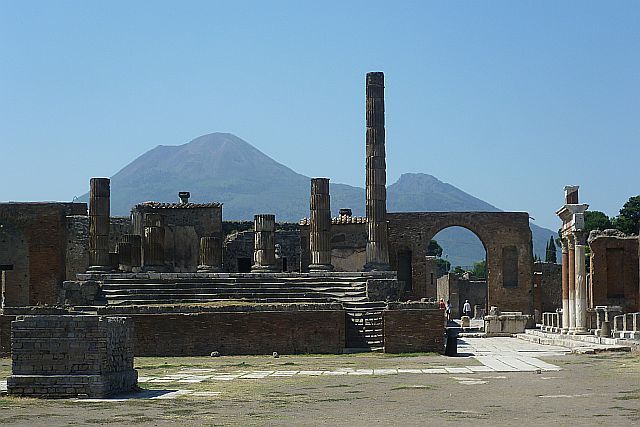During the First Century, war and illnesses were common killers in the Roman Empire. However, in the year 79 CE, Mount Vesuvius would show the city of Pompeii that a natural disaster could bring as much devastation and destruction as anything else.
In the decades before Mount Vesuvius engulfed Pompeii in ashes, an earthquake had struck the region. While the earthquake did not devastate the region, people there did not comprehend the amount of death and destruction that a natural disaster was capable of. In 79 CE, the beautiful and thriving city of Pompeii in the Roman Empire was a popular location for the wealthy and merchants to flock to. Historians have placed the population of Pompeii and neighboring region between 10,000 and 20,000 people. 1 Unfortunately, in the month of August, the city of Pompeii would be transformed from a jewel to ruins by one of the most powerful and devastating natural forces: a volcanic eruption.

Although nature provided warning signs of the catastrophic event that would soon follow, people were not able to comprehend them. Animals were dying because of their lungs being filled with toxic gas, a strong odor filled the countryside of Pompeii, and worse of all, earthquakes rattled the ground below as a result of the pressure from the magma.
On the morning of August 24, 79 CE, a strong blast from Mount Vesuvius that resulted in smoke arising from the crater drew people’s attention to the volcano, but the people of Pompeii did not panic or evacuate. Worse was yet to come. Around noon, the second explosion took place. This explosion was much stronger. A mushroom cloud shot into the sky at a distance of 27 miles. The explosion was estimated to be 100,000 times stronger than the bomb dropped on Hiroshima.2
The eruption that caused the mushroom cloud was so strong that it could have been witnessed hundreds of miles away. Pliny the Younger, an eyewitness, was so horrified and amazed by the cloud that he could not help but describe it in awe:
A cloud, from which mountain was uncertain, at this distance (but it was found afterwards to come from Mount Vesuvius), was ascending, the appearance of which I cannot give you a more exact description of than by likening it to that of a pine-tree, for it shot up to a great height in the form of a very tall trunk, which spread itself out at the top into a sort of branch.3
For those who decided not to flee Pompeii in the wake of the eruption, death was almost certain. As the eruption lasted a day, every passing hour meant more ash and toxic gas. If somehow people managed to survive breathing the toxic gas, the volcanic ashes were sure to kill them. Since structures in Pompeii were not built to carry as much weight as the ash covering them, many structures collapsed, resulting in the deaths of people who found refuge in them.
By the time Mount Vesuvius stopped ejecting ash and toxic gas into the air, ash covered Pompeii. The entire city of Pompeii was gone. What once was a vibrant city was reduced to a pile of ash. In fact, to this day a third of the city remains in ash. Although Mount Vesuvius has not erupted since 1944, an eruption is imminent; hopefully the destruction of the next eruption will not be as severe as the one in 79 CE.
- Encyclopedia Britannica, September 2016, s.v. “Pompeii Ancient City, Italy,” by Wilhelmia Feemster Jashemski. ↵
- Encyclopedia Britannica, September 2016, s.v. “Pompeii Ancient City, Italy,” by Wilhelmia Feemster Jashemski. ↵
- Charles W. Eloit, The Harvard Classics Volume 9 (New York: P.F. Collier & Son. 1909-10), 285. ↵



68 comments
Natalie Childs
While I had know of the eruption of Mount Vesuvius and the destruction that it caused in Pompeii and the surrounding areas, I hadn’t known much more than that. I really liked the picture of current day Mount Vesuvius, because it shows just how much was the volcano was lost in the eruption. The eruption that occurred really shows just how much destruction that mother nature can inflict.
Tyler Thompson
It’s crazy to think that the people of Pompeii did not want to evacuate the city after many visible signs of danger. Many of the wild life was dying, and there was a lot of ash during the first two rounds of the explosion. It’s even crazier to think that there would be so much accumulated ash heavy enough to bring down a building. Nature is unpredictable, and the city of Pompeii unfortunately had to live through it.
Kailan Pena
I’ve heard of this tragic natural disaster in different history classes in my life, but I never really remember the specifics that this article provides. I didn’t know there were any first-person sources on the horrible events that transpired that day, so it was interesting to read that. I also had no idea that Mount Vesuvius is gonna erupt again, that’s pretty exciting to me.
Hector Garcia
It’s astonishing to see the effects of an event this magnitude can still be seen today. It is terrible to read about how people of Pompeii lost their lives to this natural disaster. So far, I was able to see that this article was well-researched. What stood out to me the most would be the description of Pliny the Younger and how he described the mushroom cloud that was created from Mount Vesuvius’ explosion.
Julian Aguero
The situation the people of Pompeii are beyond horrific. The sound and sight of the explosion must have left the unfortunate people in pure terror. Its devastating that the people of Pompeii unfortunately never saw the signs. Pompeii must have been a truly beautiful place with tremendous landscape. I wish I could envision what a volcanic eruption like the one of Pompeii looked liked without the devastation of an entire population. Great article hopefully one day I can visit to see the massiveness of this Volcano.
Jason Garcia
I can’t imagine the amount of destruction that a volcanic eruption can cause. In Modern times we have ways of evacuating and telling people that a volcano may erupt and the people can be saved. But back then before they knew anything that we know now, it must have been the scariest thing a person can witness. Most thought they were safe in their homes only to be killed and encased in ash. I wish we could see what Pompeii looked like and compare it to what we see now. It must be tragic and heartbreaking
Samuel Ruiz
It is hard to imagine what went through the minds of those people who never saw what was coming. All of the signs were there, but technology, knowledge, and awareness were not very reliable at that time, especially since those people had never experienced the actions of a volcano before. This article gave great insight into just hoe destructive this disaster was, especially with detail of damage caused by the event.
Destiny Flores
I’ve actually had the privilege to visit Pompeii. All the top half of the buildings are missing and they have, in glass cases, cadavers left from the disaster. The bodies are permanently encased in a thick layer of ash and most are stuck in positions that show the amount of agony they endured til their death. For those not washed away by the tsunami, or taken by the fires that wreaked havoc, they were suffocated by the ash that engulfed the city. Tragic.
Alexis Renteria
Very interesting article. Just looking at the picture you provided of the enormous volcano i can imagine how terrifying an event like this could have been for the people in Pompeii even when they didn’t know what was coming to them. I’m glad that an event like this sparked awareness towards possible natural disasters that could happen in the future
Matthew Rios
It’s unfortunate that the people of Pompeii had not yet had the knowledge of how to respond to a volcano erupting right beside you. You would think such warnings would create some sense of panic in the Pompeii people to flee, but I suppose it’s hard to understand the mindset of people entirely at the moment. Common sense now is not the same as it was back then.